Chapter: Object Oriented Programming and Data Structure : Linear Data Structures
Evaluating arithmetic expressions
Evaluating arithmetic expressions
An example that demonstrated how to evaluate simple arithmetic expression such as 34 * 12. Now we are going to extend this problem to that of evaluating more complex arithmetic expressions. Initially, we are going to see how to handle expressions like
20 - 3 *
6 + 2
Eventually
we will extend the basic algorithm to also handle parentheses, making it
possible to evaluate expressions like
4 * ( 6 -
2 * (4 - 2))
Tokens
Because
we are going to have to deal with inputs made up of many parts that have to be
processed in an algorithm, the first step is to transform our input into a
collection of objects that we can manipulate. If our input comes to us in the
form of a String and the elements of the input are properly separated by
spaces, we can start by using the String class's split() method to split the
input String into an array of Strings.
This
solves the problem of separating the input into individual elements we can
manipulate. We are also going to go one step further, turning each of these
elements into an object called a Token.
Tokens
come in three basic types: numbers, operators, and parentheses. Tokens of type
number have an associated numeric value, while operators will have an
associated precedence value.
The TokenStack class
The basic
algorithm for handling arithmetic expressions without parentheses makes use of
a data structure called a stack. A stack is a container for a collection of
data items. The data items are organized as a stack, with the first item to
enter the container at the bottom and the last item at the top. When new items
are added to the stack they are pushed onto the top of the stack. Items can
only be removed from the stack by popping them off the top of the stack. For
this algorithm the objects we are working with are Token objects, so we will
need to construct a stack that can hold Tokens.
The basic algorithm
We are
now ready to see the basic algorithm for computing arithmetic statements
without parentheses. The algorithm makes use of two Token Stacks, a value stack
and an operator stack. The basic algorithm processes the tokens from the input
in a simple left to right order. Any number tokens that we encounter get pushed
onto the value stack. When we encounter an operator token, we will push it onto
the operator stack. At various points in the algorithm we will process an
operator. We do this by popping the operator off of the operator stack and
popping two numbers off the value stack. We then apply the operator to the two
numbers to produce a result, package the result into a number token, and then
push the number token back onto the top of the value stack. After the
processing is complete, we discard the operator token. The most important logic
in the evaluation algorithm tells us when to process the operators sitting on
the operator stack. This logic is driven in part by the precedence of the
operators involved: the operators + and - have a precedence of 1, while the
operators * and / have a precedence of 2. Here are the key elements of the
evaluation algorithm.
• If we
encounter an operator token in the input and the operator stack is empty, we
push the
operator
token onto the operator stack.
• If we encounter an operator token in the input with a precedence that is greater than the precedence of the operator token at the top of the operator stack, we push the new operator token onto the operator stack.
• If we
encounter an operator token in the input with a precedence that is less than or
equal to the precedence of the operator token at the top of the operator stack,
we process and remove the
operator
at the top of the stack and then push the new operator token onto the operator
stack.
• When we
reach the end of the input, any operators that remain on the operator stack are
processed and removed until the operator stack is empty. At that point, there
should be only one number token left on the value stack: that number is the
result of the evaluation.
An example
Here is
an illustration of this algorithm in action. The expression we want to compute
is 2 + 3 * 4 - 6
At the
start of the algorithm both stacks are empty and the tokens are lined up in the
input.
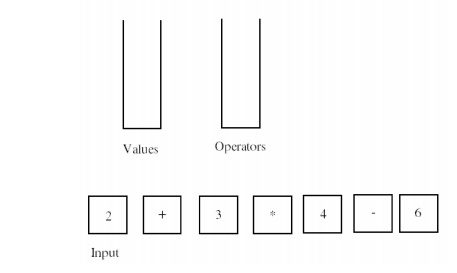
After handling the first three tokens we arrive at this configuration.
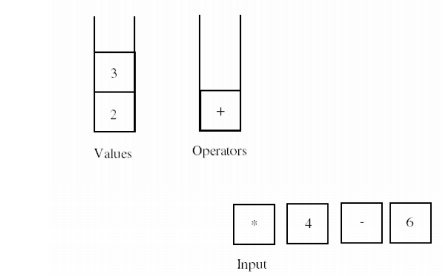
The next
operator in the input has a higher precedence than the operator at the top of
the operator stack, so we push the next operator. The next number token also
gets pushed on the value stack.
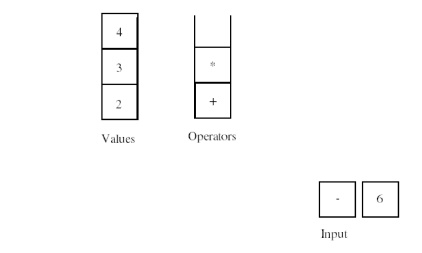
The next
operator in the input sequence has a precedence lower than that of the operator
at the top of the operator stack. This causes us to process and remove the
operator at the top of the operator stack.
Once
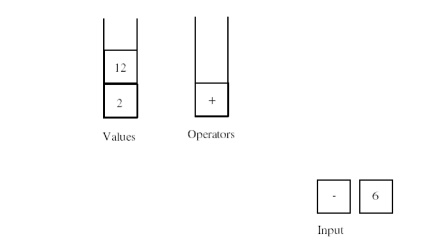
Once
again, the operator in the input has a precendence equal to that of the
operator at the top of the operator stack, so we process and remove the
operator from the operator stack.
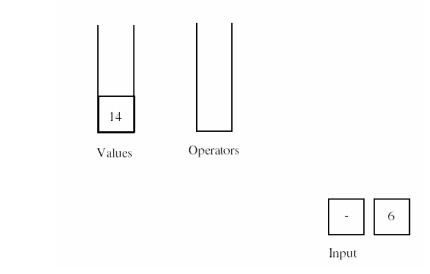
At this
point the operator stack is empty, so the operator token at the front of the
input gets pushed on the operator stack. The number token at the end of the
input gets pushed on the value stack.
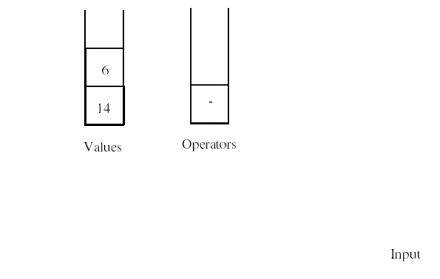
Once the
input has emptied out, we process any operators that remain on the operator
stack. Once all of those operators have been processed, the sole remaining
number on the value stack is the result of the computation.
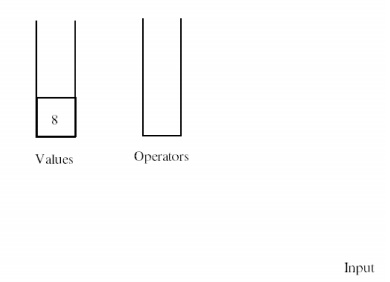
Handling parentheses
The
algorithm outlined above can easily be extended to also handle parentheses
correctly. All that is required is a couple of additional rules.
• When we encounter a left parentheses token in the input, we push that token on the operator stack.
• When we encounter a right parenthesis token in the input, we process operator s and remove them from the top of the operator stack until a left parenthesis appears at the top of the operator stack. We then pop off the left parenthesis token and discard both of the parenthesis tokens.
Related Topics